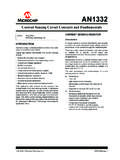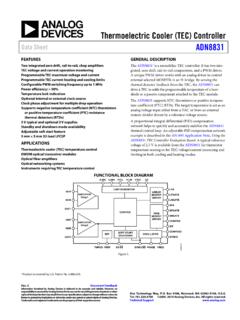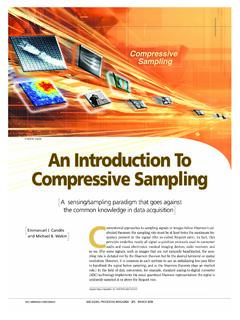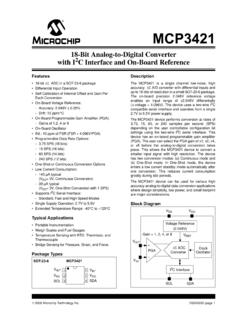Transcription of ADXL335 (Rev. B) - Analog Devices
1 Small, Low Power, 3-Axis 3 gAccelerometer ADXL335 Rev. B Information furnished by Analog Devices is believed to be accurate and reliable. However, no responsibility is assumed by Analog Devices for its use, nor for any infringements of patents or other rights of third parties that may result from its use. Specifications subject to change without notice. No license is granted by implication or otherwise under any patent or patent rights of Analog Devices . Trademarks and registered trademarks are the property of their respective owners. One Technology Way, Box 9106, Norwood, MA 02062-9106, : Fax: 2009 2010 Analog Devices , Inc. All rights reserved. FEATURES 3-axis sensing Small, low profile package 4 mm 4 mm mm LFCSP Low power : 350 A (typical) Single-supply operation: V to V 10,000 g shock survival Excellent temperature stability BW adjustment with a single capacitor per axis RoHS/WEEE lead-free compliant APPLICATIONS Cost sensitive, low power, motion- and tilt- sensing applications Mobile Devices Gaming systems Disk drive protection Image stabilization Sports and health Devices GENERAL DESCRIPTION The ADXL335 is a small, thin, low power, complete 3-axis accel-erometer with signal conditioned voltage outputs.
2 The product measures acceleration with a minimum full-scale range of 3 g. It can measure the static acceleration of gravity in tilt- sensing applications, as well as dynamic acceleration resulting from motion, shock, or vibration. The user selects the bandwidth of the accelerometer using the CX, CY, and CZ capacitors at the XOUT, YOUT, and ZOUT pins. Bandwidths can be selected to suit the application, with a range of Hz to 1600 Hz for the X and Y axes, and a range of Hz to 550 Hz for the Z axis. The ADXL335 is available in a small, low profile, 4 mm 4 mm mm, 16-lead, plastic lead frame chip scale package (LFCSP_LQ). FUNCTIONAL BLOCK DIAGRAM 07808-0013-AXISSENSORAC AMPDEMODOUTPUT AMPOUTPUT AMPOUTPUT AMPVSCOMSTXOUTYOUTZOUT+3 VCXCYCZADXL335~32k ~32k ~32k CDC Figure 1. ADXL335 Rev. B | Page 2 of 16 TABLE OF CONTENTS Features .. 1 Applications .. 1 General Description .. 1 Functional Block Diagram .. 1 Revision History .. 2 Specifications .. 3 Absolute Maximum Ratings.
3 4 ESD Caution .. 4 Pin Configuration and Function Descriptions .. 5 Typical Performance Characteristics .. 6 Theory of Operation .. 10 Mechanical Sensor .. 10 Performance .. 10 Applications Information .. 11 Power Supply Decoupling .. 11 Setting the Bandwidth Using CX, CY, and CZ .. 11 Self-Test .. 11 Design Trade-Offs for Selecting Filter Characteristics: The Noise/BW Trade-Off .. 11 Use with Operating Voltages Other Than 3 V .. 12 Axes of Acceleration Sensitivity .. 12 Layout and Design Recommendations .. 13 Outline Dimensions .. 14 Ordering Guide .. 14 REVISION HISTORY 1/10 Rev. A to Rev. B Changes to Figure 21 .. 9 7/09 Rev. 0 to Rev. A Changes to Figure 22 .. 9 Changes to Outline Dimensions .. 14 1/09 Revision 0: Initial Version ADXL335 Rev. B | Page 3 of 16 SPECIFICATIONS TA = 25 C, VS = 3 V, CX = CY = CZ = F, acceleration = 0 g, unless otherwise noted. All minimum and maximum specifications are guaranteed. Typical specifications are not guaranteed. Table 1. Parameter Conditions Min Typ Max Unit SENSOR INPUT Each axis Measurement Range 3 g Nonlinearity % of full scale % Package Alignment Error 1 Degrees Interaxis Alignment Error Degrees Cross-Axis Sensitivity1 1 %
4 SENSITIVITY (RATIOMETRIC)2 Each axis Sensitivity at XOUT, YOUT, ZOUT VS = 3 V 270 300 330 mV/g Sensitivity Change Due to Temperature3 VS = 3 V %/ C ZERO g BIAS LEVEL (RATIOMETRIC) 0 g Voltage at XOUT, YOUT VS = 3 V V 0 g Voltage at ZOUT VS = 3 V V 0 g Offset vs. Temperature 1 mg/ C NOISE PERFORMANCE Noise Density XOUT, YOUT 150 g/ Hz rms Noise Density ZOUT 300 g/ Hz rms FREQUENCY RESPONSE4 Bandwidth XOUT.
5 YOUT5 No external filter 1600 Hz Bandwidth ZOUT5 No external filter 550 Hz RFILT Tolerance 32 15% k Sensor Resonant Frequency kHz SELF-TEST6 Logic Input Low + V Logic Input High + V ST Actuation Current +60 A Output Change at XOUT Self-Test 0 to Self-Test 1 150 325 600 mV Output Change at YOUT Self-Test 0 to Self-Test 1 +150 +325 +600 mV Output Change at ZOUT Self-Test 0 to Self-Test 1 +150 +550 +1000 mV OUTPUT AMPLIFIER Output Swing Low No load V Output Swing High No load V POWER SUPPLY Operating Voltage Range V Supply Current VS = 3 V 350 A Turn-On Time7 No external filter 1 ms TEMPERATURE Operating Temperature Range 40 +85 C 1 Defined as coupling between any two axes.
6 2 Sensitivity is essentially ratiometric to VS. 3 Defined as the output change from ambient-to-maximum temperature or ambient-to-minimum temperature. 4 Actual frequency response controlled by user-supplied external filter capacitors (CX, CY, CZ). 5 Bandwidth with external capacitors = 1/(2 32 k C). For CX, CY = F, bandwidth = kHz. For CZ = F, bandwidth = 500 Hz. For CX, CY, CZ = 10 F, bandwidth = Hz. 6 Self-test response changes cubically with VS. 7 Turn-on time is dependent on CX, CY, CZ and is approximately 160 CX or CY or CZ + 1 ms, where CX, CY, CZ are in microfarads ( F). ADXL335 Rev. B | Page 4 of 16 ABSOLUTE MAXIMUM RATINGS Table 2. Parameter Rating Acceleration (Any Axis, Unpowered) 10,000 g Acceleration (Any Axis, Powered) 10,000 g VS V to + V All Other Pins (COM V) to (VS + V) Output Short-Circuit Duration (Any Pin to Common) Indefinite Temperature Range (Powered) 55 C to +125 C Temperature Range (Storage) 65 C to +150 C Stresses above those listed under Absolute Maximum Ratings may cause permanent damage to the device.
7 This is a stress rating only; functional operation of the device at these or any other conditions above those indicated in the operational section of this specification is not implied. Exposure to absolute maximum rating conditions for extended periods may affect device reliability. ESD CAUTION ADXL335 Rev. B | Page 5 of 16 PIN CONFIGURATION AND FUNCTION DESCRIPTIONS 07808-003 NOTES1. EXPOSED PAD IS NOT INTERNALLY CONNECTED BUT SHOULD BE SOLDERED FOR MECHANICAL = NO CONNECTNC1ST2 COM3NC4 XOUT12NC11 YOUT10NC9 COMCOMCOMZOUT567816NC15VS14VS13 NCADXL335 TOP VIEW(Not to Scale)+Z+X+Y Figure 2. Pin Configuration Table 3. Pin Function Descriptions Pin No. Mnemonic Description 1 NC No 2 ST Self-Test. 3 COM Common.
8 4 NC No 5 COM Common. 6 COM Common. 7 COM Common. 8 ZOUT Z Channel Output. 9 NC No 10 YOUT Y Channel Output. 11 NC No Connect.
9 1 12 XOUT X Channel Output. 13 NC No Connect. 1 14 VS Supply Voltage ( V to V). 15 VS Supply Voltage ( V to V). 16 NC No Connect. 1 EP Exposed Pad Not internally connected. Solder for mechanical integrity. 1 NC pins are not internally connected and can be tied to COM pins, unless otherwise noted. ADXL335 Rev. B | Page 6 of 16 TYPICAL PERFORMANCE CHARACTERISTICS N > 1000 for all typical performance plots, unless otherwise noted. OF POPULATIONOUTPUT (V)07808-005 Figure 3. X-Axis Zero g Bias at 25 C, VS = 3 V OF POPULATIONOUTPUT (V)07808-006 Figure 4.
10 Y-Axis Zero g Bias at 25 C, VS = 3 V OF POPULATIONOUTPUT (V)07808-0070510152025 Figure 5. Z-Axis Zero g Bias at 25 C, VS = 3 V % OF POPULATIONVOLTS (V)07808-008010203040 6. X-Axis Self-Test Response at 25 C, VS = 3 V % OF POPULATIONVOLTS (V) 7. Y-Axis Self-Test Response at 25 C, VS = 3 V % OF POPULATIONVOLTS (V) 8. Z-Axis Self-Test Response at 25 C, VS = 3 V ADXL335 Rev. B | Page 7 of 16 % OF POPULATIONTEMPERATURE COEFFICIENT (mg/ C)051015202530 9. X-Axis Zero g Bias Temperature Coefficient, VS = 3 V % OF POPULATIONTEMPERATURE COEFFICIENT (mg/ C)010204030 10. Y-Axis Zero g Bias Temperature Coefficient, VS = 3 V % OF POPULATIONTEMPERATURE COEFFICIENT (mg/ C)05101520 7 6 5 4 3 2 10123456707808-013 Figure 11. Z-Axis Zero g Bias Temperature Coefficient, VS = 3 V 40 30 20 100 102030405060708090100N = 8 TEMPERATURE ( C)OUTPUT (V)07808-014 Figure 12. X-Axis Zero g Bias vs.















